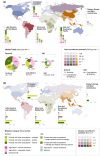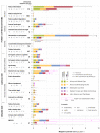Land-based measures to mitigate climate change: Potential and feasibility by country
- PMID: 34636101
- PMCID: PMC9293189
- DOI: 10.1111/gcb.15873
Land-based measures to mitigate climate change: Potential and feasibility by country
Abstract
Land-based climate mitigation measures have gained significant attention and importance in public and private sector climate policies. Building on previous studies, we refine and update the mitigation potentials for 20 land-based measures in >200 countries and five regions, comparing "bottom-up" sectoral estimates with integrated assessment models (IAMs). We also assess implementation feasibility at the country level. Cost-effective (available up to $100/tCO2 eq) land-based mitigation is 8-13.8 GtCO2 eq yr-1 between 2020 and 2050, with the bottom end of this range representing the IAM median and the upper end representing the sectoral estimate. The cost-effective sectoral estimate is about 40% of available technical potential and is in line with achieving a 1.5°C pathway in 2050. Compared to technical potentials, cost-effective estimates represent a more realistic and actionable target for policy. The cost-effective potential is approximately 50% from forests and other ecosystems, 35% from agriculture, and 15% from demand-side measures. The potential varies sixfold across the five regions assessed (0.75-4.8 GtCO2eq yr-1 ) and the top 15 countries account for about 60% of the global potential. Protection of forests and other ecosystems and demand-side measures present particularly high mitigation efficiency, high provision of co-benefits, and relatively lower costs. The feasibility assessment suggests that governance, economic investment, and socio-cultural conditions influence the likelihood that land-based mitigation potentials are realized. A substantial portion of potential (80%) is in developing countries and LDCs, where feasibility barriers are of greatest concern. Assisting countries to overcome barriers may result in significant quantities of near-term, low-cost mitigation while locally achieving important climate adaptation and development benefits. Opportunities among countries vary widely depending on types of land-based measures available, their potential co-benefits and risks, and their feasibility. Enhanced investments and country-specific plans that accommodate this complexity are urgently needed to realize the large global potential from improved land stewardship.
Keywords: AFOLU; co-benefits; demand management; feasibility; land management; land sector; mitigation; natural climate solutions; nature-based solutions.
© 2021 The Authors. Global Change Biology published by John Wiley & Sons Ltd.
Figures









References
-
- Ahenkan, A. (2019). Financing climate change mitigation: An assessment of the private sector investment opportunities in Ghana. Business Strategy and Development, 3(1), 143–150. 10.1002/bsd2.84 - DOI
-
- Austin, K. G. , Baker, J. S. , Sohngen, B. L. , Wade, C. M. , Daigneault, A. , Ohrel, S. B. , Ragnauth, S. , & Bean, A. (2020). The economic costs of planting, preserving, and managing the world’s forests to mitigate climate change. Nature Communications, 11(1), 5946. 10.1038/s41467-020-19578-z - DOI - PMC - PubMed
-
- Bailis, R. , Drigo, R. , Ghilardi, A. , & Masera, O. (2015). The carbon footprint of traditional woodfuels. Nature Climate Change, 5(3), 266–272. 10.1038/nclimate2491 - DOI
-
- Bajželj, B. , Richards, K. S. , Allwood, J. M. , Smith, P. , Dennis, J. S. , Curmi, E. , & Gilligan, C. A. (2014). Importance of food‐demand management for climate mitigation. Nature Climate Change, 4(10), 924–929. 10.1038/nclimate2353 - DOI
-
- Barlow, J. , Gardner, T. A. , Araujo, I. S. , Avila‐Pires, T. C. , Bonaldo, A. B. , Costa, J. E. , Esposito, M. C. , Ferreira, L. V. , Hawes, J. , Hernandez, M. I. M. , Hoogmoed, M. S. , Leite, R. N. , Lo‐Man‐Hung, N. F. , Malcolm, J. R. , Martins, M. B. , Mestre, L. A. M. , Miranda‐Santos, R. , Nunes‐Gutjahr, A. L. , Overal, W. L. , … Peres, C. A. (2007). Quantifying the biodiversity value of tropical primary, secondary, and plantation forests. Proceedings of the National Academy of Sciences, 104(47), 18555–18560. 10.1073/pnas.0703333104 - DOI - PMC - PubMed
MeSH terms
LinkOut - more resources
Full Text Sources
Medical

